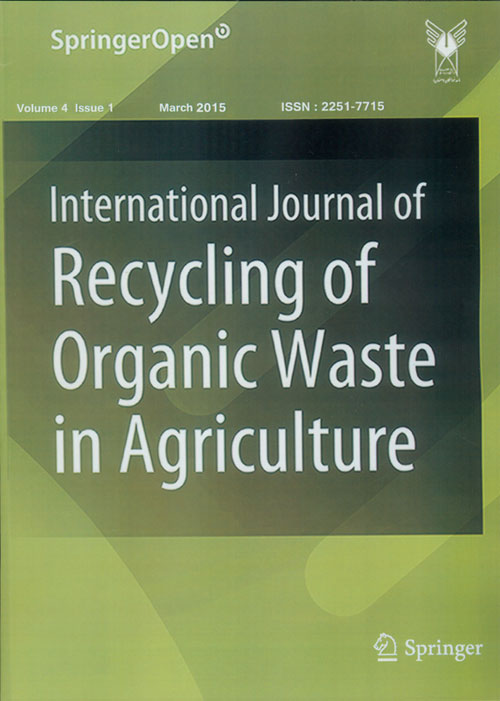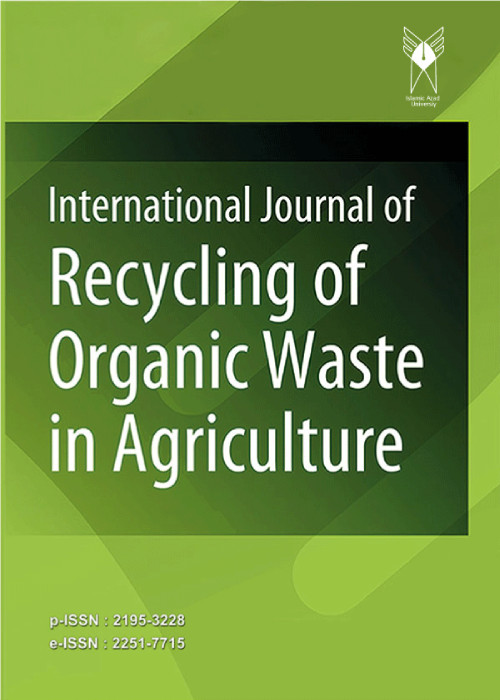فهرست مطالب

International Journal of Recycling of Organic Waste in Agriculture
Volume:4 Issue: 1, Winter 2015
- 62 صفحه،
- تاریخ انتشار: 1393/12/10
- تعداد عناوین: 7
-
-
Page 1
Introduction Palm oil mill effluent (POME) contains large quantities of organic matter in the form of total suspended solids (TSS), volatile suspended solids (VSS), total solids (TS), oil and grease (O & G) that increase biochemical oxygen demand (BOD) and chemical oxygen demand (COD) of POME if left untreated. The main aim of the present study was to investigate the ability of bacterial strains either pure (individually) or mixed (combinations), to degrade and metabolize organic load from palm oil mill effluent. Results Sequencing of the 16S rRNA of the isolates suggests that they were identified as Micrococcus luteus 101 PB, Stenotrophomonas maltophilia 102 PB, Bacillus cereus 103 PB, Providencia vermicola 104 PB, Klebsiella pneumoniae 105 PB and Bacillus subtilis 106 PB. The use of mixed cultures in the present study showed more extensive removal of organic load (COD and BOD) than pure single cultures. Mixed cultures were found to reduce the pollutant dynamically. Thus, the mixed cultures C1 (Bacillus cereus 103 PB and Bacillus subtilis 106 PB) were the most effective bacterial combination for use in biological treatment technology of POME having the highest COD and BOD reduction rate. C1 produced the highest degradative activity in reducing COD (90.64 %) and BOD (93.11 %). Conclusion The indigenous microbial isolates from POME were observed to possess potential to degrade organic components whereas the use of mixed cultures resulted in more extensive degradation of COD and BOD than pure single cultures. This suggests that mixed culture of bacteria in the present study can be used for bioremediation of environment contaminated with polluted wastewaters. This study, however, indicates the prospect of isolating indigenous microorganisms in the POME for effective biotreatment of POME.
Keywords: Bacteria. BOD. COD. Organic load. POME. Reduction. Treatment. Wastewater -
Page 11
This research is aimed to study comparison of the effects of applied nanozeolite and zeolite on aggregation and organic carbon (OC) in each aggregate size fraction in treated soil with different levels of some plant residues and incubation for 90 days. The analysis of variance showed that the effects of applied nanozeolite, zeolite, plant residues, and their interaction and incubation times on MWDw and OC in aggregate size fractions were statistically significant. The results showed that MWDw and OC contents in each aggregate size fraction increased with the additions of nanozeolite, zeolite, and plant residues. This study also revealed that nanozeolite and alfalfa straw were more effective for increasing the MWDw and OC contents in aggregate size fractions than zeolite and wheat straw, respectively. In other words, higher percentage nanozeolite, zeolite, and plant residues resulted in increasing the MWDw and OC in aggregate size fractions. The highest amounts of OC were observed in A and B compounds compared with the control and other treatments. However, the comparison of OC contents in all the treatments showed that proportion of nanozeolite for increasing the OC content was greater than that of zeolite. Also the highest OC contents were observed in larger aggregate size fractions. The MWDw and OC contents increased with the increasing days of incubation in treated soil. Thus, it was concluded that compound A can be more effective to improve the soil carbon sequestration.
Keywords: Nanozeolite. Zeolite. Plant residue. Organic carbon. Aggregation. Incubation -
Page 23Introduction
Textile industry produces large quantities of highly colored effluents, which are generally toxic and resistant to biodegradation. The present study was carried out to find out the efficiency of using gamma radiation to degrade or decontaminate combined textile effluent and its potential application as irrigation water on spleen amaranth.
ResultsThe change of absorption spectra, physicochemical parameters of gamma-irradiated textile effluent revealed that all these properties have improved after irradiation at (10–15) kGy. Analysis of ammonium and total nitrogen concentration of the effluent also showed that both of them are increased after irradiation and can be used for irrigation purposes. Application of irradiated textile effluents on spleen amaranth have increased dry mass (10.77 g), plant height (10.53/week), root length (19.00 cm), number of leaves (6/week) compared to the plants which were nourished with raw textile effluent and only water. Elemental analysis showed trace amount of heavy metal uptake by the plant. Moreover, the plants contain mineral nutrients essential for plant growth.
ConclusionsThe treatment of textile effluents by gamma irradiation (10–15 kGy) is a promising tool as it produces zero waste and has the possibility of alternative use for irrigation water with fertilizing properties.
Keywords: Textile effluent – Gamma radiation – Plant – Irrigation water – Fertilizing effect -
Page 31Background
In India, fishmeal is habitually considered as the major protein source for fish culture. Rising cost, deteriorating quality and unavailability of fishmeal caused huge difficulty in modern aquaculture, particularly for fish nutrition. Nearly all Anabas testudineus cultures faced loss, due to high feed costs, inappropriate feed formulation and management. So it was necessary to find a profitable replacement of fishmeal, which could provide better growth performance to A. testudineus.
ResultsIn this study, different types of poultry wastes were tested, and poultry viscera confirmed satisfactory results, having 60.67 % crude protein (% Dry matter basis). Further, a feeding trial was conducted for 60 days in 90-L circular fibre tanks with proper aeration, to evaluate poultry viscera, in the formulated diet for A. testudineus. Triplicate groups of fingerlings each were fed four isonitrogenous diets, at 5 % of wet body weight basis. Feed readjusted biweekly. Comparatively, fish accumulated highest and significant (P < 0.05) increase in body weight and fat deposition, when dietary fishmeal completely replaced by poultry viscera.
DiscussionsThus, this study revealed that better growth performance in Koi, A. testudineus (Bloch) could be achieved through utilization of poultry viscera in the formulated fish feed, compared to fishmeal. Hence, poultry waste recycling could be stimulated also.Electronic supplementary material: The online version of this article (doi:10.1007/s40093-014-0082-y) contains supplementary material, which is available to authorized users.
Keywords: Crude protein – Fishmeal – Koi – Poultry viscera – Proximate composition -
Page 39Purpose
Owing to aridity in our agro-ecosystem, mineralization of organic substrate is quite rapid and thereafter volatilized due to lower matrix affinity. In these consequences, the study has been chalked out with the hypothesis to alter the best approaches for mineralization of available organic resources as soil supplement to reduce the economic burden on the farming community. Our laboratory study showed the sequential temporal variations in physic-chemical properties of available organic substrates such as farm manure and sugar industry waste during composting/vermicomposting.
MethodsThe organic material obtained from the farm manure of live-stock farm and another sources of industrial organic waste {sugarcane baggase (SCB), pressmud (SPM), mixture of SCB, SPM and sugarcane effluent} were used for this mineralization perspectives. However, all organic substrates properties remained static except moisture up to a period of 21 days. Thereafter, these produced and processed matrix was subsequently composted and vermicomposted during 45 days under normal shade. No earthworms were spiked in composting while Lumbricus rubellus collected near vicinity of research area were inoculated at the rate of 50 g/kg of waste in vermicomposting. Contrarily, their applications was mandated as and when required policy subsequently. Moisture and temperature status of substrates were monitored regularly. However, compost/vermicompost substrates were assessed @ 15 days interval to evaluate temporal changes in physico-chemical characteristics.
ResultsVermicomposting of farm manure and sugar industry wastes produced best quality manure with enriched nutritional status comprising more OC (4 %), N (3 %), P (2 %), K (7 %), Ca (3.5 %), Na (2.5 %), SO 4 −2 (3.1 %) and B (twofold) as compared to composting.
ConclusionInoculation of local specie for vermicomposting is a viable option to be recommended to the farming community.
Keywords: Composting, Vermicomposting, Raw organic sources, Local earth worms, Chemical change -
Page 53Background
Present research communicates the role of Eisenia fetida in converting pulp and paper mill sludge into valuable products by removing the high concentration of different chlorophenols and metals present in the sludge.
ResultsPulp and paper mill sludge was toxic to Eisenia fetida and therefore, it was mixed with composted material in different ratio of experimental set up such as Set up: 1, (95:5), Set up: 2 (80:20) and Set up: 3 (50:50) on dry weight basis. We found very promising results by the application Eisenia fetida in the sludge. Eisenia fetida removed all the twelve different chlorophenols more than 95 % from the sludge which is declared as carcinogenic compounds by United States Environmental Protection Agency (US-EPA) in 90 days of incubation. Heavy metals concentration was decreased significantly during the incubation period whereas some metal concentration was also increased in the sludge due to mineralization. Carbon (C) and Nitrogen (N) were increased in the composted material, C:N ratio for Set 1 9:4 in Set 2 13:4 and Set 3 18:4 was observed which acts as soil conditioner. Whereas some other metals like (Ca, Mg, Na, K, Fe and Zn) was increased that are essential for the plant growth. There was great reduction in adsorbable organic halogen (AOX) 95 % and extractable organic halogen (EOX) 90 % as compare to control. Eisenia fetida also removed pentachlorophenol (PCP) from the sludge with artificially increased concentration about 100 mg/kg.
ConclusionsBy observing chlorophenols concentration, metals and carbon–nitrogen ratio, Eisenia fetida is acting as a potential candidate for the reclamation of industrial sludge. The result indicated that vermicomposting with Eisenia fetida is better option to manage the sludge or convert the sludge into nutrient-rich composted material in a short span of time.
Keywords: Eisenia fetida, Chlorophenols, Vermicompost, Sludge, Pulp, paper mill, AOX, EOX, Metals -
Page 63
Shortage of irrigation water is a crucial problem in arid and semi-arid regions. Therefore, application of wastewater in such area seems to be an indispensable solution. The health aspect of the application should be considered by microbial evaluation of soil and plant irrigated with treated wastewater. In this study several irrigation methods were used. Results showed that the filtration reduced the microbial pollution of treated municipal wastewater. The maximum soil pollution was in the surface drip and furrow irrigation with treated municipal wastewater. The least level of total and fecal coliform were in sub-surface drip irrigation at the depth of 30 cm in condition of municipal wastewater reuse. The results of plants revealed that the highest coliforms were seen at the surface drip and furrow irrigation with treated municipal wastewater. The minimum coliforms numbers were observed in the sub-surface drip irrigation method. Therefore, the sub-surface drip irrigation can reduce the wastewater reuse problems at soil and plant. It is the best option to avoid the contamination in landscape.
Keywords: Irrigation method, Microbial contamination, Municipal wastewater, Landscape


